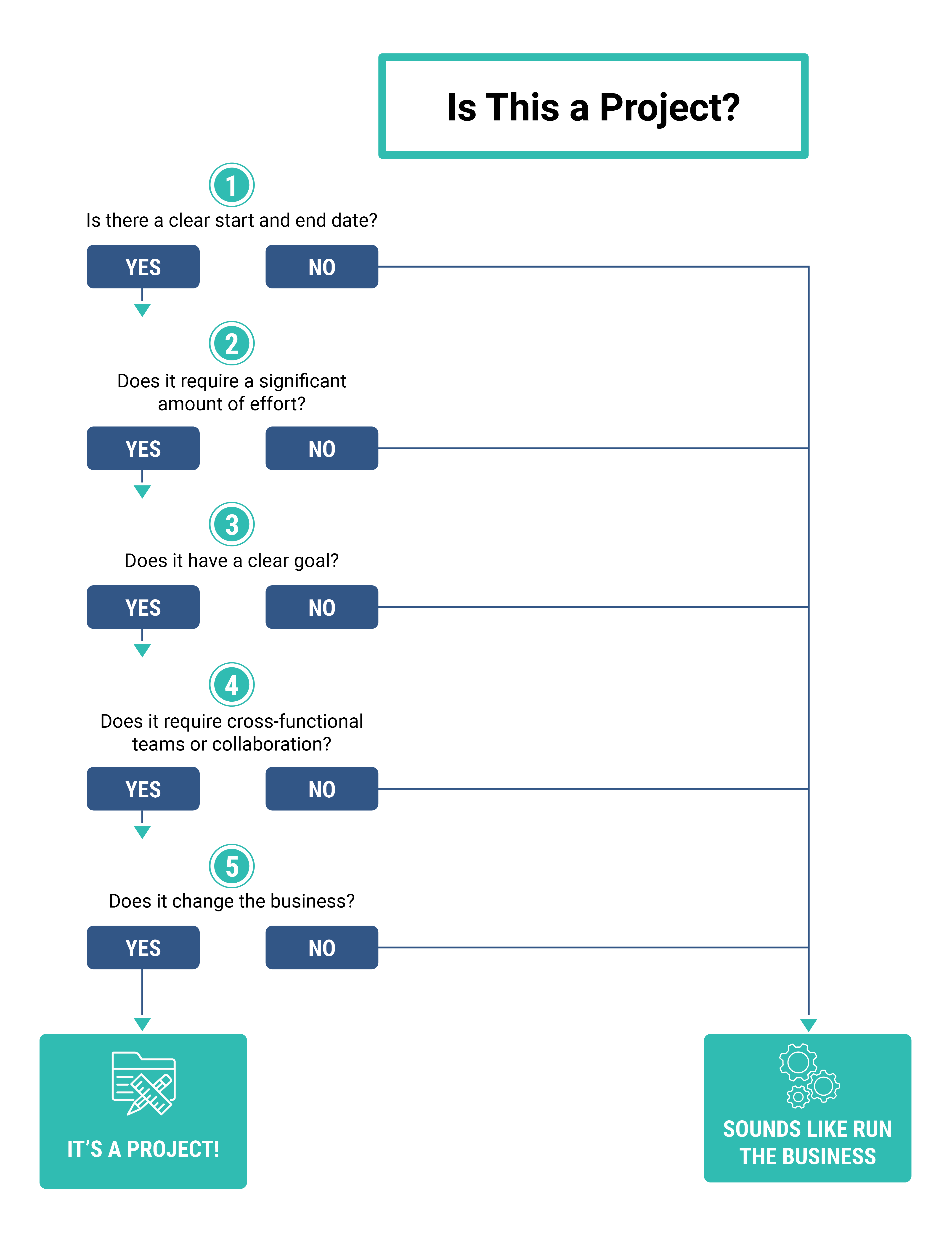The difference between work that is a project versus work that is Run the Business (RTB) might seem small, but the implications can be huge. Successful organizations know how to balance these two types of work. However, if you’re buried under projects and proposed initiatives, you might struggle to see the light at the end of the tunnel. To have a well-balanced project portfolio, you first need to make sure you’re properly defining what work and activities are RTB and what work is definable as a project.
Run the Business (RTB) vs. Projects
Run the Business (RTB) is also referred to as Business as Usual (BAU) or Keep the Lights On (KTLO). Whatever acronym you prefer to use, it describes any work done by an organization that is necessary for normal operations. Common examples of RTB activities include administration activities (like running payroll) but can also include customer service activities, regular maintenance on machinery or software or any cyclical work an organization does on a recurring basis.

In contrast, projects include work that aims to change or grow the business. Projects (and/or programs) help businesses reach corporate goals, enter new markets, explore new opportunities and evolve to meet market or customer demands. It’s easy to see how both RTB and projects are necessary for a business, but you don’t have an unlimited amount of time and workers, so you will have to do some prioritizing in terms of how much you will devote yourself (or others) to each one. Not enough projects and your company won’t grow, change or evolve, but not enough time and budget for RTB and things start to fall apart.
Determining What is a Project
We’ve tried to provide a clear definition for both Run the Business and project work, but we also understand that things aren’t always so black and white. Determining if certain work is actually Run the Business or a project is sometimes difficult. We recommend using multiple dimensions to evaluate and determine if work is a project or RTB. Below are some of the most commonly used dimensions for defining a project. If you’re struggling with sorting projects from RTB activities, start with three to five of these dimensions and change them or add more as needed.
- Effort - An easy litmus test for whether certain work is RTB or a project is the required effort. Work that has a small demand is likely RTB while larger demands tend to be a project. Organizations could even set a specific threshold for work where anything above this threshold is a project and anything below is RTB.
- Goal - Projects should be clearly aligned to one (or possibly more) corporate goal. If certain work cannot be easily aligned, it might be RTB. However, it is also possible that a proposed project cannot be easily aligned because it’s not relevant to your organization’s current strategy.
- Timeline - According to the Project Management Institute, a project is “a temporary endeavor undertaken to create a unique project service or result.” They key word here is “temporary.” Projects have clear start and end dates. If something requires ongoing work, it’s likely RTB.
- Definability - One clear characteristic of a project is that it can be clearly defined. This means the timeline, scope of work, effort required, goal and deliverables are specific and describable.
- Teaming - Looking at who exactly would be doing certain work can help define whether it’s a project or RTB. Projects typically rely on cross-functional teams to execute, so if a proposed project doesn’t require cross-functional collaboration (or collaboration of any kind), it probably falls under the RTB umbrella.
- Change - Projects seek to create or introduce change in your business. Ask yourself if a proposed project will create change. If it doesn’t, it might not be a project.
- Risk - Another indicator for determining if certain work is a project is the risk level. Because projects aim to make changes to the business, they have a higher risk than RTB which doesn’t change the business but focuses on activities that keep the lights on. You likely already assess risk for all projects and new initiatives anyway, so this is an easy factor to use to determine projects.
- Funding - Projects are usually funded with the capital budget while Run the Business is funded by operating expenses.

Balancing Run the Business with Projects
So now that you know how to define work, you’re ready to balance RTB with projects. Organizations often struggle with achieving this balance because they don’t understand the importance of RTB activities and/or don’t make resources available. In an effort to continually grow and change the business, organizations sometimes flood their project portfolio with too many projects and not enough resources for RTB. While RTB work might not be as exciting as projects, it needs to be properly prioritized.
It’s helpful to make a list of all RTB activities that are absolutely necessary for your business to keep running. Once you have this list, allocate resources to these activities before allocating resources to projects. It’s important that these allocations stay in place. It may be tempting when you are in a pinch to pull workers off RTB work for other projects, but this should not be done (unless you are experiencing truly unprecedented circumstances).

Once you have determined and allocated your RTB activities, the rest of your resource capacity can be devoted to projects. If you feel like you are allocating too many resources to RTB activities, it could mean a couple of things. First, it could be that senior management or other stakeholders want more projects in the project portfolio than you can reasonably deliver with the available resources. When this happens, you can consider hiring more resources (including external ones) to meet the project demand or you can reschedule projects to a time when resources are available. Alternatively, you could consider projects that might reduce RTB capacity by automating certain activities or creating more efficiencies. Second, it may be possible that some RTB activities are not absolutely crucial. Regularly review RTB activities and make sure they only include things that are necessary. If there are RTB activities that aren’t crucial, but you’d still like to have, you can keep them in your project portfolio but you should consider evaluating and prioritizing them alongside projects rather than other RTB work.
Learn to Juggle Run the Business and Projects with Meisterplan
If trying to juggle crucial RTB work with projects has given you a headache, you’re not the only one. It’s a difficult task to do and if you’d like to do it successfully (and without headaches) you need a tool that simplifies the job. As a project portfolio and resource management tool, Meisterplan makes it easy to see RTB and project work side by side. You can quickly prioritize projects and RTB, search and allocate the right resources and identify where resources bottlenecks are going to occur. To see Meisterplan in action and learn how you can easily juggle run the business with projects, take our guided product tour.



